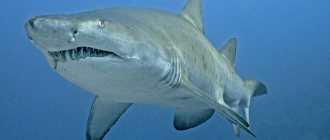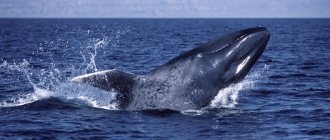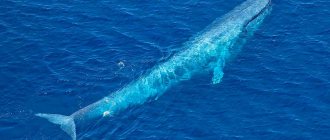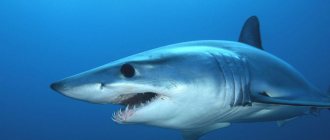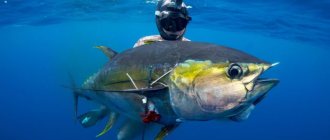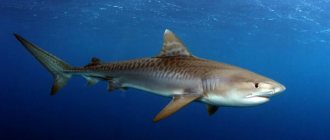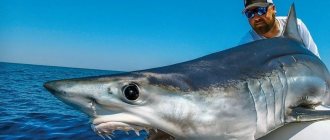This shark, also known as the bigmouth shark, is one of three species of sharks living today that feed on plankton.
This group also includes the basking shark and the whale shark. The Latin name for the largemouth shark is Megachasma pelagios.
This shark, which lives at great depths, was discovered in 1976. And today it is the only species of the family of largemouth sharks (Latin name Megachasmidae).
As of November 2004, it was possible to observe largemouth sharks in numbers not reaching 25 individuals, only a small part of which scientists were able to study. Therefore, there is very little information about the habitat of this shark, its anatomy and behavior.
Peculiarities
Pelagic largemouth shark (Megachasma pelagios).
The largest specimen of a largemouth shark that could be measured was a dead female, discovered on April 19, 2001, washed up by the waves on the coast of Tokyo Bay near the city of Ichihara. Its length was 5.63 m. And on March 13, 2004, the smallest specimen of this shark species was caught near the island of Sumatra. It turned out to be a male, whose length was 1.77 m.
The distinctive external feature of this shark is its large, round, short-nosed head and huge mouth. It is because of her that it got its name. The back of the largemouth shark is dark brown, the belly is a lighter shade. This shark has two dorsal fins, two pectoral fins of fairly large size, one caudal fin, which has an asymmetrical shape, and two pairs of fins on the stomach, with the back pair being much smaller than the front.
Whale shark
The safest shark for humans is the whale shark. Don't be afraid of her huge mouth and thousands of teeth. Due to its narrow throat, it eats exclusively plankton and krill. She physically cannot swallow larger prey. Therefore, when swimming near people and large sea inhabitants, it often closes its mouth. Moreover, whale sharks are very friendly to people; divers and divers often say that you can calmly pet them and swim next to them.
Spreading
Largemouth sharks feed on plankton.
Largemouth sharks have been seen in the Pacific, Atlantic and Indian oceans, most often off the coast of Japan and California. This gives scientists the right to claim that this type of shark is distributed throughout the globe, but prefers waters of relatively warm latitudes.
It is assumed that the mating of largemouth sharks occurs in the fall in the waters near California, since it was in these places that the largest number of adult males of this species were found at sexual maturity.
Whiskered nurse shark
The nurse shark is considered relatively harmless to humans. Their individuals grow up to 4 m in length and have strong jaws with a huge number of small but sharp teeth. These sharks are slow and often swim in small groups. They are indifferent towards people, provided they do not feel in danger. Divers and divers claim that you can safely swim and dive next to baleen sharks if you do not frighten them or provoke them into self-defense, since in case of danger they can still bite a person.
Nutrition
A model of a largemouth shark in a museum.
Based on studies of what was found in the stomachs of deceased largemouth sharks, it can be concluded that the main food of these fish is various small organisms, such as krill. The largemouth shark has the ability to suck in water, which it needs to filter. This distinguishes it from the basking shark, which can only passively filter water that contains plankton. Whether the largemouth shark feeds on small fish or not has not yet been established.
Caribbean reef shark
An encounter with a Caribbean reef shark can be frightening to the unknowing. And it’s not surprising, because the sight of a 10-meter shark, whose mass reaches 80 kg, is not conducive to emotion. But appearances are deceiving, and this species is truly harmless to humans. Moreover, many divers feed these sharks so that they can swim with them later. Maybe that's why they are not interested in people? After all, why attack someone who brings you food himself?
In addition to their indifferent attitude towards people, Caribbean reef sharks differ from their fellow sharks in their love of sleep. In caves at the bottom of the sea, they can sleep for hours, filtering water through gill slits and without the need to move.
Another amazing fact about these sharks is that they “cooperate” with small fish. A school of small fish always swims next to them, ridding their larger partners of parasites, in return receiving protection and the opportunity to pick up food that falls out of the shark’s mouth.
Behavior
An incident helped study the behavior of the largemouth shark. In October 1990, in the coastal waters of California, scientists were lucky enough to catch a live male largemouth shark, whose length was 5 meters. For the first time, a radio transmitter was attached to this male, after which he was released. Thanks to this event, the first information appeared about the migratory routes of the largemouth shark, and in addition, about its movements in the vertical direction.
The largemouth shark is a unique and rare creature.
Thus, scientists have learned that the largemouth shark spends the night time at a depth not exceeding 15 m. But in the daytime, it can descend to a depth of 150 m. It is assumed that the largemouth shark makes these movements in pursuit of krill, which is characterized by a similar daily change in depth location.
Where does this name come from?
The largemouth shark, according to the few existing documents, looks like a mixture of a whale and a representative of a shark. The family, in which this animal is the only representative, received its name for its huge mouth, which is necessary for swallowing masses of water . This individual is one of three subspecies that do not lead an active predatory lifestyle. Along with tiger and giant sharks, this animal “weeds out” small crustaceans from the water.
The prefix “pelagic” in the form of these individuals means that they live away from the continental shelf at a depth of over 100 meters. Representatives of this family belong to oceanic fish and prefer warm waters, for example, near Hawaii and California. The largemouth shark is extremely rare and is the only representative of its family.
Opening
There is no reliable evidence that largemouth sharks were known to people in previous centuries and centuries. However, it can be assumed that it was they who laid the foundation for the legends about sea monsters, which were supposedly a cross between a shark and a whale.
It is believed that the largemouth shark was mentioned in ancient legends about monsters that lived in the waters of the World Ocean.
The first specimen of a largemouth shark was caught in Hawaii, more precisely near the island of Oahu, which was documented on November 15, 1976, which was subsequently described. This specimen turned out to be a male, 4.46 m long. He was caught by the crew of an American research vessel, who discovered that this male was trying to bite through the cables in the water, as a result of which he himself became entangled in them. This individual was carefully studied. A stuffed specimen of this male largemouth shark remains in the Honolulu Museum to this day.
If you find an error, please select a piece of text and press Ctrl+Enter.
Natural predators and enemies of the largemouth shark
As mentioned above, the largemouth shark has few natural predators, which is primarily due to the enormous size of the individual. However, some types of predators still hunt these animals, namely:
- rock bass;
- sperm whale;
- other sharks.
Predators take advantage of the slowness of this largemouth shark and simply tear out pieces of meat from its body, which is why many animals have scars on their bodies . The observed individuals also had marks on their faces from collisions with stingrays and jellyfish. It is unlikely that this is a direct attack, but rather a matter of self-defense, since the largemouth swallows huge masses of water in an attempt to filter out the krill.
Helicoprion
Although very little is known about them, Helicoprion is a very strange-looking fish that lived 280-225 million years ago. A distinctive feature of this shark is its dental spiral. In modern sharks, teeth grow throughout their lives, and old ones fall out. Ancient sharks had old teeth along with new ones. In some species, old teeth were moved onto the face to make room for teeth in the jaw. In helicoprions, these teeth were wrapped in a circle.
Bearded wobbegong
These sharks are found in shallow water corals off the coast of Australia, New Guinea and the islands of this region. Their variegated coloring and fringe provide them with excellent camouflage among corals. The maximum recorded body length of this species was 1.8 meters. There have been several recorded unprovoked attacks by carpet wobbegongs on humans, so people should handle this species with caution.
Bearded wobbegong
Tags: sharks, animals, fish
Rate this article:
(votes: 49 , rating: 4.73 out of 5)
Where does the giant shark live?
Photo: Giant shark underwater
The natural habitat of basking sharks includes:
- Pacific Ocean. Sharks live off the coasts of Chile, Korea, Peru, Japan, China, Zealand, Australia, California, Tasmania;
- North and Mediterranean Sea;
- Atlantic Ocean. These fish were spotted off the coast of Iceland, Norway, Brazil, Argentina, Florida;
- waters of Great Britain and Scotland.
Basking sharks live only in cool and warm waters. They prefer water temperatures between eight and fourteen degrees Celsius. However, sometimes these fish swim into warmer waters. Shark habitats have a depth of up to nine hundred and ten meters. People meet giant sharks in narrow outlets from bays or off the coast. These fish like to swim close to the surface with their fins sticking out.
Sharks of this species are migratory. Their movements are associated with changes in temperature in their habitat and redistribution of plankton. It is generally accepted that in winter, sharks descend into deep water, and in summer they move to a shallow area near the shore. This is how they survive when temperatures drop. Giant sharks are able to travel vast distances in search of food. This became known thanks to scientists' observations of tagged fish.
Etmopterus perryi
This species is probably the smallest among the entire variety of sharks, since the maximum size of an individual does not exceed 21 centimeters. This shark has photophores with which it can emit a glow. They live in the Atlantic Ocean off the coast of Colombia and Venezuela. Due to insufficient research on this species, the level of danger to humans remains unknown.
Etmopterus perryi
Social structure and reproduction
Photo: Giant shark in the water
Basking sharks can be called social animals. They can exist either alone or as part of a small flock. Typically, schools of such fish number no more than four individuals. Only occasionally can sharks move in huge schools - up to hundreds of heads. In a school, sharks behave calmly and peacefully. Basking sharks grow very slowly. Puberty occurs only at age twelve, or even later. Fish are ready to reproduce when they reach a body length of at least four meters.
The breeding season of fish occurs during the warm season. In the spring, sharks break into pairs and mate in shallow coastal waters. Little is known about the reproductive process of basking sharks. Presumably, the female's gestation period lasts at least one year and can reach three and a half years. The lack of information is due to the fact that pregnant sharks of this species were caught extremely rarely. Pregnant females try to stay deep. There they give birth to their young.
The cubs are not connected to the mother through a placental connection. First they feed on yellow eggs, then on eggs that have not been fertilized. During one pregnancy, a basking shark can carry five to six cubs. Baby sharks are born 1.5 meters long.
Cigar or glow shark
The cigar shark (Isistius brasiliensis) gets its strange name from its habit of biting off chunks of prey meat by twisting the victim's body in a circular motion. It's just that the fish it bites into are too big to eat whole. The cigar shark is only 50 cm long, but it can bite into whales, submarines and people. She has a small bioluminescent spot on her body that makes others think she is a much smaller fish than she actually is, while the cigar shark lurks in the dark.
The most terrible inhabitants of the sea abyss
These animals hide at various ocean depths. Photos and videos of the inhabitants of the seabed may surprise you.
1. Shark lizard
This shark lives thousands of meters below the surface of the water, but sometimes it surfaces. Perhaps to remind us how unusual the inhabitants of the ocean are. This rarely seen shark inhabits the depths of the Atlantic and Pacific oceans. Scientists believe that it catches its prey by bending its body and lunging forward, like a snake when attacking, to swallow the victim whole.
2. Deep-sea eel with a mouth like a pelican
An eel with a pelican's head. You can meet this creature at a depth of about one thousand meters; its body length reaches two meters. Bigmouth is probably one of the strangest looking deep sea creatures lurking in the depths of the ocean. With a huge mouth, the pelican is capable of swallowing things much larger than its own size.
3. Saberfish
Despite having such an aggressive-sounding name (its teeth, in proportion to its body, are the largest of any ocean creature), the Sabretooth is quite small and harmless to humans. Horrifying looking, but safe. This is one of the deepest sea animals. A fish with monstrous fangs was discovered at a depth of more than 5,000 meters, where the pressure is 500 times higher than on Earth. A person in such conditions would be flattened like a pancake.
4. Viperfish from the Pacific Ocean
While during the day the viper fish remains in the depths, at night it moves to shallower territory, often getting caught in the nets of sea fishermen. They do not survive in captivity, but this way they were studied in more detail. With its appearance, the viper fish fully deserves a place on the list of sea monsters. The Pacific viperfish lives at depths of over one thousand meters and attracts prey with an insidious light.
5. Monkfish
Named for its methods of searching for prey, the anglerfish, or monkfish, uses a fleshy appendage protruding from the top of its head as bait to attract its prey. The monkfish lives at a depth of 2000 meters and attracts its prey in a similar way, using light, like the viper fish. The only difference is that the strange glowing antenna comes out of his head. This makes him look like the scary predator from the cartoon Finding Nemo.
6. Stargazer fish or seabird
The astrologer buries itself in the sand and waits for its prey. Its head always remains up and its eyes look up, and its body structure is ideal for this hunting technique. These fish make their way underground in the sand and leap upward to attack their prey as it swims by. In addition, some varieties are electric and are capable of shocking the victim.
7. Giant Spider Crab
This is the largest crab existing on the planet. It lives approximately 300 meters below sea level, and its claws grow over three meters long.
8. Giant isopod
You can see this arthropod with a 30-centimeter body at a level of more than 2000 meters under water. First and foremost, he is a scavenger with a ferocious appetite.
9. Goblin shark or goblin shark
Little is known about this deep sea creature, as only a few specimens have ever been caught by fishing boats, but those rare sightings have been enough to earn it a fearsome reputation. With a prominent snout and retractable jaws, the goblin shark's physical characteristics are worthy of its name. The goblin shark reaches up to 3.5 meters in length and lives more than 1,300 meters below the sea surface.
10. Giant squid Architeuthis
Rarely seen by humans, the giant squid has become the stuff of legends over the centuries. It lives deep underwater, its only real enemy is the sperm whale. In fact, these two giants are known for their deep sea battles, and their bodies are often found with signs of mortal combat. The length of this giant squid reaches 18 meters, which is equivalent to a six-story building.
11. Blind lobster Dinochelus ausubeli
This lobster was discovered only in 2007 in the depths of the ocean near the Philippines.
12. Large Mouth Shark
Since its discovery in 1976, this extremely rare species of deep-sea shark has rarely been spotted by humans and there is as yet no agreement in the scientific community on how to actually classify it. The most distinctive feature is its gaping mouth, which the largemouth shark uses to swallow plankton and fish. The pelagic largemouth shark grows up to 5.5 meters, and the rare deep-sea animal feeds on plankton.
13. Giant marine polychaete worm
The length of an adult predator can reach an incredible 2-3 meters, and its appearance will make you truly horrified.
14. Dragon fish
Despite the fact that it lives at depths of almost two kilometers, the dragon fish is born from eggs actually on the surface of the ocean. Like many other deep-sea creatures, she eventually becomes capable of creating her own light, using a technique known as bioluminescence, and then retreats into the depths. One of the many light-emitting photophores can be found on the barbel attached to the lower jaw, which the dragonfish most likely uses to search for food.
15. Vampire Squid
With the largest eyes (in proportion to its body) of any animal in the world, this deep sea creature is born to live in the depths. And despite the name, the vampire does not suck blood; in fact, its tentacles do not have suction cups. The squid's name comes from its intensely red eyes and cape.
16. Big red jellyfish
This amazingly large jellyfish can grow over one meter in length and has a distinctive red coloration. Instead of tentacles, the deep sea jellyfish uses a series of fleshy “arms” to capture its prey.
17. Drop fish
Primarily found in the deep waters off Australia and New Zealand, the blobfish lives at depths of more than 1,200 meters. The pressure here is several dozen times higher than at the surface, so its body is a gelatinous mass.
18. Coffin fish
Resembling a pink hot air balloon, these deep sea hunters are something of a cross between a dogfish and a monkfish. Although they lure their prey using bloat, they also transform into a ball when threatened.
19. Chimera fish
Not to be confused with the chimera of Greek mythology, these creatures are also known as phantom sharks, and although they live in all layers of the oceans, today they are mainly limited to the deep sea level.
20. Amphipod
Although these tiny crustaceans are usually no larger than an inch, in the depths of the Pacific Ocean floor, about 6 kilometers from the surface, they can grow up to 30 centimeters in length.
21. Dumbo the Octopus
Named after the elephant in the Disney film, this octopus isn't quite as terrifying as the frillied shark, but it looks just as scary from the outside.
22. Snaggletooth
There's no way to describe this deep sea creature without using some "very ugly" words. Like several other species on this list, due to living in such depths, the snaggletooth is capable of creating its own light and uses this ability to search for prey.
23. Axefish
To avoid confusion with the freshwater carnegiella found in many home aquariums, this species is named for its distinctive axe-shaped body shape. Living at extreme depths, the fish has two tubular eyes that point upward to make it easier to catch food coming from above.
24. Opisthoproct
Also known as ghost fish, these strange-looking creatures are similar to hatchet fish in that they have two upward-pointing eyes to better locate prey. Their distinguishing feature, however, is their transparent head.
25. Grenadier fish
One of the more prominent deep sea inhabitants, the grenadier is estimated to make up about 15 percent of the deep sea population. Grenadiers can be found at depths greater than 6 kilometers; there are few other creatures that can survive in such a hostile environment.
26. Blue-ringed octopuses
Although it may not look as physically imposing as some of the other creatures on this list, the blue-ringed octopus is one of the most dangerous animals in the ocean. Its poison is extremely powerful and there is no antidote for it.
27. Black Crookshanks
The Black Crookshank is famous for its ability to swallow prey that is much larger than itself. It is small in size, but can actually swallow prey ten times its own weight.
Based on materials from: cameralabs.org, LifeGlobe
Mako
This species is considered the fastest of all existing sharks, and it is also one of the most aggressive species of sharks that poses a danger to humans. They are capable of reaching speeds of over 70 kilometers per hour, and can jump out of the water to a height of 6 meters. Makos are widespread in temperate and tropical waters of all oceans. The maximum length of their body reaches almost 4.5 meters.
Mako
